A Summary Report
National Seminar on
Social Structure of Tribal India: Concepts, Debates and Empirical Realities
(November 22-23, 2019)
By Kanchan Bharati and Dhananjay Kumar
Anthropologists and sociologists have for long focused their studies on the tribal communities of India on their culture (sanskriti) comprised of ecology, agriculture, arts, crafts, dance, language, folklore religion, festivals, witchcraft and so on. However, studies of social structure (samaj) of the tribes have been relatively sidelined. Hence we have lesser knowledge of their groups, classes and categories, such as family and marriage, lineage and clan, the network of kinship and affinity and their political structure. During the 1960s some anthropologists/sociologists have initiated studies on the social structure of the tribals of eastern and central India. But not many studies have been done in the western part of the country.
To fill the lacunae, especially in the context of western India, the Centre for Culture and Development (CCD) had studied the social structures of five major tribes namely, Gamit, Vasava, Chaudhri, Kokna and Warli of south Gujarat. On completion of these studies, Centre has organized a two-day National Seminar on ‘Social Structure of Tribal India: Concepts, Debates, and Empirical Realities’ during 22-23 November 2019. The seminar aimed to be a forum to discuss and debate the theoretical, conceptual and empirical issues arising out of studies of the tribals of Gujarat, and by extension, those of India in general. It was expected to provide new insights into the tribal society in general and tribal social structure in particular. It also aimed to bring out multidimensional outcomes and prospects for further academic explorations on ‘Tribal Studies in India’.
The selected papers by the invited scholars, who have done studies on the social and political structure of tribals in India, presented an excellent understanding of the following broader themes:
- Texts and contexts of tribal studies
- Tribal identity and their political structure
- Marriage, language and social change and
- Household, kinship and marriage in South Gujarat Tribes
Lighting of Lamp
The seminar commenced with the lighting of the lamp by dignitaries, namely, Professors Vidyut Joshi, Rambhatla Siva Prasad, Premananda Panda, Ragini Shah and Lancy Lobo. After this formal inauguration, Prof. Lobo welcomed the participants and briefly introduced them to the activities of the CCD. He mainly brought forth research carried out by the Centre on caste, religion, tribe, communalism, elections, environment, health and suicide. This was followed by a round of self-introductions by the participants.
Inaugural Session
In his introductory address, Prof. Lobo stated that we should recognize that the wider political, economic and social framework within which the tribals live has been changing from time to time. This framework changed remarkably, first, during the British colonial regime, and thereafter with the enactment of the Constitution of independent India in 1950. There is as yet no definite definition of ‘tribe’ in India except the administrative one. Accordingly, the Constitution has a list of what are called ‘Scheduled Tribes’ (STs). There are a total of about 700 STs in India as a whole, of which there are 31 in Gujarat. Unlike earlier Oriental or Indological perspectives, constructed from Hindu scriptures and historical records, in the 1950s, ‘village studies’ focused on a village as the unit of study in a holistic manner with an innovative approach of fieldwork to understand the rurality which have played a crucial role in development of sociology and social anthropology in India. Though these studies brought out a vast amount of empirical reality, they were largely focused on caste-based formations rather than on tribal society. With an attempt to study tribal society in a holistic view, research by CCD on five tribal societies in their villages focused on their social structure with an added feature of horizontal dimension to some extent. Social structure largely meant the union revolving around the nucleus of household and family, lineage, clan, marriage, and network of kinship and affinity. It was pointed out that an understanding of tribal social structure is important to comprehend their larger implications, and their differences and resemblances with the neighbouring societies, both tribal and non-tribal.
I
Prof. Vidyut Joshi in his keynote address provided the landscape of the texts and contexts of ‘Tribal Studies in India’. According to Thomas Kuhn, inventor of ‘paradigm shift’, concepts and subjective assumptions are part of the perspectives a researcher holds and on the basis of which he/she interpret data. So, the text should be viewed in its contexts. By reviewing sociological and anthropological texts, Prof. Joshi highlighted that the nature and scope of tribal studies have changed in India with the change in its contexts. He classified these changes in three different phases namely (1) The British rule phase, (2) The independence phase (1947-1990) and (3) post-Rio phase (after 1990). The contexts in the first phase were marked by the British rule and their interests to know the people of India in order to rule them. Their need to administer tribals and their areas led to the starting of ethnographic studies by the British anthropologists. The paradigm of evolution dominated in these studies in which tribals were considered as ‘vestigial or remnants’ of the past. The second phase started with Indian independence and has the dominant notion of development and welfare of tribals. For this, the Indian government’s range of constitutional provisions led to set up different research institutes, university departments, Tribal Research and Training Institutes (TRTIs), Anthropology Society of India. Popular topics of these institutes were education and development, agriculture and development, forest and development. The third phase was marked by a change in development perspective with more emphasis on human rights and the inclusion of sustainable and participatory development after Rio effect. This also led to internal emergence of tribal identity and culture. Hence studies on tribal identity, culture, tribal rights and participation increased.
The next presentation by Prof. Felix Padel and was chaired by Prof. P. Panda. Based on his interaction with the tribal communities of Odisha, Jharkhand, Chhattisgarh, Prof. Padel presented a panoramic view on social change and transformation in the social structure of tribal India. He stated that since the classic anthropological monographs analyzed the social structure of India’s tribal communities during the 1920s-60s, the pace of change has been phenomenal. The process of Hinduization, Sanskritization and globalization have influenced the tribal communities. They have internalized certain customs, practices and characteristics of non-tribals thereby exhibiting change and transformation, which one can understand by observing their material and non-material culture. In Padel’s view, the intrusion of markets led to the superseding of their indigenous manufacturing skills and the extent of change in material culture. Such transitions can be understood by observing their daily used items, house structure, the economy as well as their increasing tendency towards migrant labour and its consequences. He also stated that changes in material culture have far-reaching implications on the aspects of the social organization of kinship and marriage, political organization, religious beliefs/faith, indigenous language and knowledge and so on.
II
The first session was chaired by Prof. F. Padel and had four papers. The session discussed ‘identity and political structure’ with special references of tribal India. The first speaker of the session, Prof. R. S. Prasad, who aimed to understand the tribal societies how in recent times State is changing their identity in the name of development. He argued that tribal societies are basically communitarian and are closely knit with well-defined social structural elements. In such societies, community living, communitarian values, community needs, etc., become the basis for individual identity. Thus an individual during crisis relies on the community for the fulfilment of various needs like cultural, social, economic or emotional. However, a significant change is noticeable among them due to the developmental and welfare measures introduced by the Central and State governments. In Prasad’s view, the ‘mainstream society’ is trying to convert the communitarian tribals society into individualistic societies through such programmes, policies and ‘developmental’ planning. These have done greater harm to the tribal communities as many of their institutions and social structural features are at the risk of near disappearance as well as the usurpation of tribal resources. In the name of ‘national interest’ tribals were asked to sacrifice their resources and ‘mainstreaming’ them with other evils. Such measures had rather accelerated taking over of the resources of tribals resulting in their displacement. According to him, in the enthusiasm to ‘develop’ and ‘civilize’ tribals, we are basically damaging the mosaic of pluralism, multiculturalism and multilingualism that is the basis of tribal societies.
Prof. P. Panda in his paper highlighted the traditional political structure and modern political hegemony of clan and clan clusters among tribal communities. Focusing on the ethnographic details of the political system of the Binjhal tribe of Odisha, the paper offered a cross-cultural comparison of the political hegemony of the traditional leaders in the changing political processes. It is mentioned that traditionally as distinct territorial groups, the clan having an ecological advantage in production leads over other clans economically and thus, enjoys political dominance across the ethnic groups living in the tribal habitat. Once the power is acquired, in order to maintain power and expand influence, the traditional political leader adopts various strategies to express its hegemony which includes rendering public livelihood support as well as threats of a different kind to form its state. To acclaim the traditional ruling, family banked upon the support of their close affines and collateral brothers in exchange for tax-free land and special socio-political status in society. Such structure, thus, showed the political alliances of the leader being compromised with kinship ties to acquire and maintain political power. Even in the present democratic political structure, such traditional hegemony is seen to be continued in showing its influence. Now the strategies adopted through ritual obligations have surfaced primarily to meet the realities of the present-day village politics in modern state political structure. The traditional political form remained unchanged while contents have changed.
Prof. J. C. Patel in his paper pointed out the importance of tribal perspective to view tribal identity. He argues that non-tribals, especially the Hindus, suffer prejudice against the tribals as they have their own perspective but not pay attention to the tribal perspective to understand their way of life. Giving attention to tribal culture may be one way to bridge this bias. According to him, scholars have used terms as Jana, Aadi for tribes, with the inherent expressions of original settlers of the land. They also cover some recent process in tribals such as assimilation and integration into mainstream society. He pointed out Gujarat has as many as 28 tribal groups. Traditionally, each of the group has its own governance, natural and innate monetary arrangement and social and religious structure. However, over the years, due to many factors, like education, religion, state and law, market arrangement, industry, transportation and communication, tribal way of life has been affected in many ways. As per him, scholars noted that tribals do not comprehend these effects negatively. Instead, they look at this newly, developed system with a sense of honour, respect, status and superiority. In contrast to this, they consider their own tribal arrangements, system, (social, cultural, political and linguistic) as improper. They want to shun these traditions altogether. They want to go ahead with the development changes and losing their traditional spirit of mutual co-operation, pluralism and multiculturalism. In concluding remarks he put forwarded certain guidelines as suggestions for bridging the biases. For instance, honoring and maintaining the growth and protection of physical environment, their right of social, cultural, economic development, stopping disgraceful sentiments and insulting words in relation to the lifestyle, culture, dialect and history of tribals, discourse on tribals and their way of life in the mainstream domain and giving forest rights to tribals.
In the last paper of the session, Dr. Dhiraj Kumar’s paper employed the perspective of political ecology to view the tribal political structure among the Ho’s of Jharkhand. Based on extensive field research in West Singhbhum (Jharkhand), the paper argues that state forms of development projects and schemes ( state formation) are based on accumulation strategy and hegemonisation that facilitates dull compulsion and transforming the lineage system of Adivasi as a governed class having no alternative imagination of polity. The paper discussed that the Ho tribe have a segmentary lineage system and subsistence mode of production. They are more prone to resistance against the accumulative projects of the State and are now being an object of biopolitics and governmentality. Their social structure is surrounded around the customary politics which is being in transition due to the central role that the state played in shaping the ecology and economics of the local communities. The paper noted that the state ‘will to develop Adivasi’ in the representative form of state’s formation backup with the cultural politics of participatory democratic governance, lead to the co-optation of lineage system and sacral polity by transforming them as an accumulative category.
III
The second session was chaired by Prof. J. C. Patel which had two papers. The session discussed ‘Marriage and Language Structure’ with special particular references to Gujarat tribes. The first speaker of the session, Prof. S. Joshi, discussed marriage as a social institution, its demographic dynamics and change in marriage practices among the tribal communities. These changes are the effects of the larger social process of modernization, industrialization, urbanization and economic development. It is mentioned that in the last 60 years there has been a change in the tribal communities with respect to education, landholding pattern and workforce which has direct ramifications on their socio-economic and cultural life. Migration of tribals to urban areas for employment and education opportunities brought contact with non-tribals and different culture. One can observe new emerging trends in the tribal communities such as new strata of educated and professional group/class (entrepreneur, teacher, administrators, engineers, doctors etc.), rise in the political leadership at all level, penetration of various religious sects, Sanskritization and Hinduization. Such development process, however, has divided the tribals into strata of elites and non-elites. With respect to marriage practices, the paper noted ongoing continuity with a certain change in marriage patterns. Some of the changes include the presence of exogamous marriages, reducing proportion of cross-cousin marriages, increasing amount of bride-price (up to few lakhs), increasing incidence of love marriages (with tribals or with non-tribals), individual preference of specifications for prospective spouse (in terms of looks, social strata, habits, education, occupation etc.) and cases of expensive marriages.
Dr. B. Vasava’s paper focused on the linguistic structure of tribal dialect (specific to Vasava Bhils of Narmada district), and how in changing times, its relevance is lost thus affecting the communities, structurally, socially and politically. The main objective was to understand the significance of tribal languages vis-à-vis development among tribes. It is argued that despite the protection given to the tribal population by the Constitution of India (1950), it remains the most backward ethnic group in India, on the development indicators of health, education and income. One of the factors for backwardness is language. As it becomes a barrier for tribals to understand their rights of the constitution due to low literacy and poverty. Thus their forceful and systematic exclusion from the development. Such aspect excludes tribals’ opinions and their inclusion. By highlighting specific cases such as Forest Right Draft and NABARD Watershed Projects, the paper pointed how the language acted as a barrier in understanding the tribal development and how it impacts them. Paper also noted that the young generation, especially from the urban area, do not communicate in their own dialects instead, they use dominant languages, such as Gujarat or Hindi. The paper suggests some operational strategies for development solution among the tribal areas such as translation of Indian Constitution, Acts, Policies, Programmes and Schemes in various tribal languages, media space addressing tribal issues and more funds for the development of tribal languages.
IV
The third session deal with empirical findings of the internal social organisation of five tribes namely, Gamit, Vasava, Chaudhri, Kokna and Warli in South Gujarat. The session has two parts. The first part was chaired by Prof. R. Siva Prasad and had two papers. In the first paper, Lancy Lobo and Dhananjay Kumar presented the profile of CCD’s study. They located the tribes in South Gujarat with their characteristic features, settlement pattern, habitation structure and demographic overview. They also highlighted the methodological process followed during the study. How they started a pilot study by taking one tribe in two villages. Later on, they replicated the same methodology in the other four tribes. At the concluding observation, they noted some of the points like horizontal dimension beyond the village, the difference of village revenue boundary and social boundary and observance of some sort of intertribal hierarchy in multi-tribe villages.
Followed by the profile of the study, Dhananjay Kumar and Lancy Lobo’s paper discussed the household and family structure of the five tribes. The paper delineates similarities and differences in various sizes of tribal households and families, their genealogical depth over the generations and structural compositions. It also explored the development process of the household and its relation various kinship compositions over a stretch of time and respective rights and obligations (norms). Household dimension is the least studied area in tribal family studies in Tribal India. The present study might prove significant in filling this lacuna. They concluded that in all five studies tribes, some kinship compositions have more households than others- husband-wife and unmarried children households; while some are less than others- only 19 single-member households; and some are rare- only two unmarried brothers households. Further, some kinship compositions are conspicuously absent, like unmarried brother-sister households.
The second part of the session is chaired by Prof. P. Panda and had two papers. In the first paper, Dhananjay Kumar and Lancy Lobo dealt with the kinship system, behaviour and its implications among the five tribal societies. They have analysed kinship terms by using nine criteria model of Kroeber, Lowie and Murdock. Following a rigorous analysis of each tribe in their micro-cosom, the study tried to view tribal kinship system in macro-cosom perspective. Using specific examples, the paper also analyzed how kinship relates to their day to day activities with their kin members, like kinship obligations, cases of respect and avoidance and joking relationships including a discussion on the rules and patterns of inheritance. They concluded that the nucleus of the tribal social organisation revolves around the household and family, lineage, clan and kindred. The kinship system knits together all these structures of their society. Three kinds of kinship - consanguineal (blood relative), affinal relationship (relationship by marriage) and fictive kinship are – found among tribal of south Gujarat. Looking at the national level, the tribal kinship is neither typical north Indian- nor typical south Indian, but rather belongs to a distinctive middle Indian type shared by other tribal and peasant communities.
In the last paper of the session, Lancy Lobo and Dhananjay Kumar focused on the comparative marriage networks of five tribes. It highlighted their social institutions, e.g., village endogamy, patrilineal exogamy, cross-cousin marriage, bride price, uxorilocal households, repetitive marriages, the direction of marriages, observations on ascending and descending generations and so on. Besides it also explored the types of prevalent marriages, rules of marriage in case of bigamy and widow remarriage. In the end, the paper explored the social and geographical space of the tribes of South Gujarat. Based on findings it suggested that in term of marital networks. Their Samaj is limited to a particular geographical and social space. Some changes in these patterns are observed in more recent generations.
Concluding Session
The concluding session of the seminar was chaired by Prof. L. Lobo and Prof. A. M. Shah gave his thoughts on kinship and marriage in tribal society. He raised some significant questions: How a tribe maintain its unity, identity and integrity? What is the nature of endogamy and hypergamy in tribal and non-tribal society? What are the consequences of these marriage practices? What is the role of kinship in tribal political structure? The power structure in the state and state-less tribal society? State formation in tribal society? How did lineage develop into the state? How kinship leads to kingship in tribal societies? What is the role of kinship and lineage in modern political structure in tribal areas? Whether in the household and family area jointness is also increased in tribal societies? How the changes in marriage pattern occurred in tribal societies? From bride price to bridegroom price? From freedom of divorce to marital bonding? At the last, he cautioned that the field of sociology and social anthropology of kinship and marriage is a near neglect area because it requires rigorous research.
Ensuing discussions after presentations at each sessions looked at important questions and issues that needs attention. Some of them are:
- Kind of ideas we have of tribals are problematic, like super imposition of ‘our ideas’ that we put on them and then try to evaluate them.
- Tribals are never homogeneous but idea of their ‘integration approach’ started with Indias freedom movement.
- When we talk about adivasi or tribal vis-à-vis development is it to bring them into mainstream or to destroy them in the long run?
- NGO’s operating in tribal areas are reflecting notion of non-tribals about tribals, and their needs their development
- Idea of de-development through residential schools, ashrams for tribals as they destroy cultural identity – such as folklore, language etc.
- In the assertion of tribals for preserving identity, is leadership coming from within tribals?
- There is a loss of tribal culture but at the same time one also sees revival of culture. However, exploitation of tribal arts is also reality. Monetary benefits are not reaching to tribal artisans.
- In tribal communities all kinds of conversions are taking place, like soil, water, forest and resources, but why there is more focus on religious conversion, especially of Christianity.
- In criticism of current tribal development agenda, do we have any different or alternative ‘tribal development agenda’ that could retain the basic structure of tribal intact despite ongoing changes?
- What is the concept of beauty among tribals?
- Can we relate skewed sex ratio (in some communities) as important factor for the marriage between tribal girl and non-tribal boy, rather than the process of sanstkritization and other social changes?
- In what way the tribal girls are integrated into caste structure and their kinship relations?
- What is the linguistic structure of tribals?
- What are the implications of imposed revenue boundaries on tribals?
- Whether kinship terms/reference changes over time?
- Whether there is tribal awakening with reference to continuum process of sanskritization and hindutvaization?
- Avoid using term of village, for the tribal areas/ habitats. Instead we can use ‘settlement units’.
- With respect to five tribes (CCD):
- Whether there are any wrong unions or prohibited marriages but practiced?
- What is the level of jointness among the households and how it gets reflected in legal dimension?
- What are the implication of terms address?
- Whether we need to emphasize village or lineage exogamy and are they different or similar?
- Whether there is the possibility of difference – of the concept of property in tribals and its succession?
- Does there exist a link between exchange of women and exchange of property?
- If the process of hinduization is going on among tribals, how it is effecting the inheritance pattern of tribals?
- Possibility of classifying household type v/s inheritance.
- With reference to inheritance and property it is important to define ‘partible and impartible’ property.
- How kinship terms would be viewed from feminist perspective?
- What are the barriers /stimulants that allow multiple relations and duties?
- Incidences of leviratic /sorroratic marriages.
- Any restrictions among the consanguine marriages.
In sum, the seminar was an intensive and clinical academic attempt that discussed and debated about the empirical realities of the social and political structure of tribal societies. The seminar allowed us to see them in the contexts of socio-political structure, along with an understanding of how far they have retained or changed their identity and socio-cultural system.

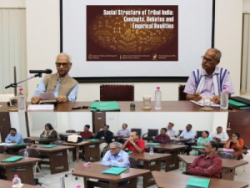
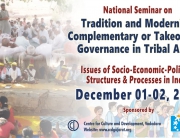
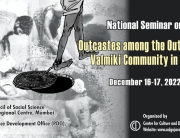
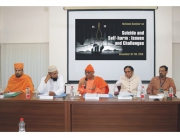
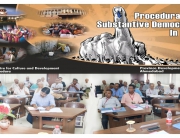
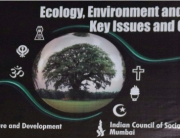
Add Comment